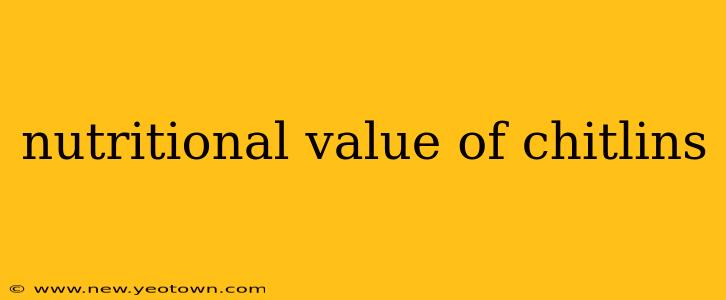Chitlins, or chitterlings, might not be the first thing that springs to mind when you think of healthy eating. Often associated with soul food traditions and a strong, acquired taste, these humble offal – the small intestines of pigs – possess a nutritional profile that deserves a closer look. This isn't just about tradition; it's about understanding the surprising nutritional value hidden within this often-overlooked food.
My grandmother, bless her soul, used to make the most incredible chitlin' stew. The aroma alone would draw the whole neighborhood in! While the rich flavor was always a highlight, I only recently discovered the full nutritional story behind this family favorite. Let’s delve into it together.
What Exactly Are Chitlins?
Before we dive into the nutritional benefits, let's clarify what chitlins actually are. They are the small intestines of pigs, meticulously cleaned and prepared before cooking. The preparation process is crucial, as improper cleaning can result in a less-than-pleasant culinary experience. The thorough cleaning is essential not only for taste but also for safety, removing any potential contaminants.
The Nutritional Powerhouse: A Breakdown of Chitlin's Nutrients
While the taste might be an acquired one, the nutritional benefits of chitlins are undeniable. They are a surprisingly good source of several essential nutrients:
-
High in Protein: Chitlins are an excellent source of protein, essential for building and repairing tissues. This makes them a valuable addition to a balanced diet, especially for those seeking to increase their protein intake.
-
Rich in Iron: Often overlooked, chitlins offer a significant amount of iron, a vital mineral for red blood cell production and oxygen transport throughout the body. This is particularly beneficial for individuals prone to iron deficiency anemia.
-
Good Source of B Vitamins: Chitlins are a good source of several B vitamins, including B12, crucial for nerve function and red blood cell formation. These vitamins are essential for maintaining energy levels and overall health.
-
Source of Zinc: Zinc is another essential mineral found in chitlins, playing a critical role in immune function, wound healing, and cell growth.
Are Chitlins Healthy? A Balanced Perspective
While chitlins offer a range of nutrients, it's important to approach them with a balanced perspective. The healthiness of chitlins depends largely on how they are prepared. Over-frying or using excessive amounts of fat during cooking can negate some of the nutritional benefits and increase the fat and cholesterol content.
Therefore, opting for healthier cooking methods like stewing or baking is recommended to maximize the nutritional value while minimizing the potential negative impacts.
How to Prepare Chitlins for Optimal Nutrition
The preparation process significantly impacts the taste and nutritional value of chitlins. Proper cleaning and cooking are essential.
-
Thorough Cleaning: This is the most crucial step. Chitlins must be meticulously cleaned to remove any residual matter.
-
Healthy Cooking Methods: Stewing or baking is preferable to frying, reducing the fat content and preserving more nutrients.
-
Seasoning: Seasoning is key to enhancing the flavor. Experiment with herbs and spices to create delicious and healthy chitlin dishes.
Frequently Asked Questions (PAAs)
Here are some common questions about the nutritional value of chitlins, addressed to provide a comprehensive understanding:
Are chitlins high in cholesterol?
Yes, chitlins can be relatively high in cholesterol, due to their organ meat nature. However, the amount of cholesterol consumed depends greatly on the preparation method. Healthy cooking methods can help mitigate this concern.
What are the health benefits of eating chitlins?
The health benefits include a good source of protein, iron, B vitamins, and zinc. These nutrients contribute to various bodily functions, including energy production, immune support, and red blood cell formation.
Are chitlins good for weight loss?
Chitlins are a good source of protein, which can help with satiety. However, the overall impact on weight loss depends heavily on portion control and preparation methods. High-fat preparations will likely hinder weight loss efforts.
What are the potential risks of eating chitlins?
The primary risk is associated with improper cleaning, leading to foodborne illnesses. Thorough cleaning and safe cooking practices are vital to mitigate this risk. Additionally, those with high cholesterol should consume chitlins in moderation.
In conclusion, chitlins, when properly prepared, offer a surprising array of nutritional benefits. While they might not be a daily staple for everyone, their inclusion in a balanced and varied diet, with careful consideration of preparation methods, can contribute positively to overall health and wellness. Remember, moderation and healthy cooking are key to reaping the rewards of this often-overlooked food.

